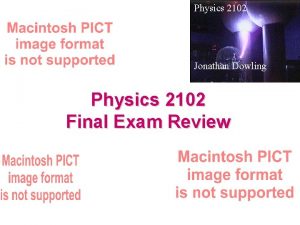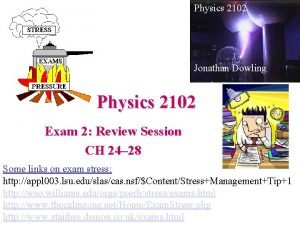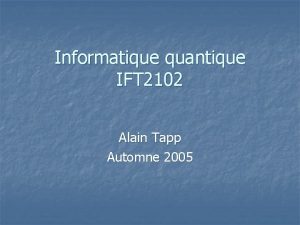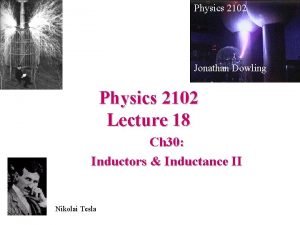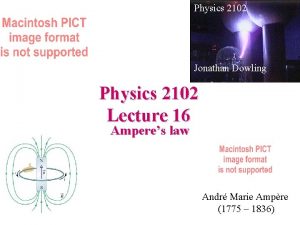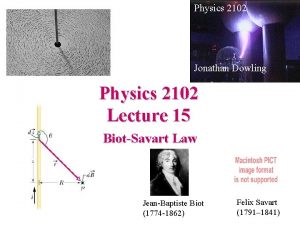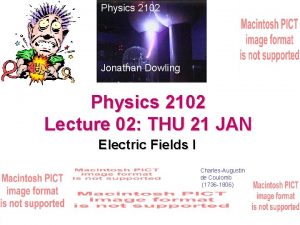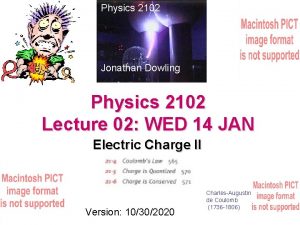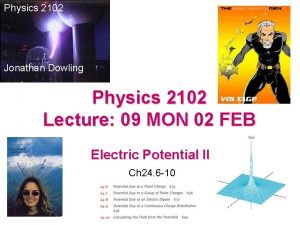Physics 2102 Jonathan Dowling Physics 2102 Lecture 08



![Electric Potential Energy, Electric Potential Units : Potential Energy = U = [J] = Electric Potential Energy, Electric Potential Units : Potential Energy = U = [J] =](https://slidetodoc.com/presentation_image/ac9b6a21301f79c19cbb55962f37a41d/image-4.jpg)






- Slides: 10

Physics 2102 Jonathan Dowling Physics 2102 Lecture: 08 FRI 30 JAN Electric Potential I Ch 24. 1 -5 Danger!

Electric Potential Energy U is Negative of the Work W to Bring Charges in From Infinity: U = –W∞ The Change in Potential Energy U Between an Initial and Final Configuration Is Negative the Work W Done by the Electrostatic Forces: U = Uf - Ui = -W +Q • What is the potential energy of a single –Q +Q a charge? • What is the potential energy of a dipole? • A proton moves from point i to point f in a uniform electric field, as shown. - Does the electric field do positive or negative work on the proton? - Does the electric potential energy of the proton increase or decrease?

Electric Potential Electric potential difference between two points = work per unit charge needed to move a charge between the two points: V = Vf – Vi = –W/q = U/q
![Electric Potential Energy Electric Potential Units Potential Energy U J Electric Potential Energy, Electric Potential Units : Potential Energy = U = [J] =](https://slidetodoc.com/presentation_image/ac9b6a21301f79c19cbb55962f37a41d/image-4.jpg)
Electric Potential Energy, Electric Potential Units : Potential Energy = U = [J] = Joules Electric Potential = V = U/q = [J/C] = [Nm/C] = [V] = Volts Electric Field = E = [N/C] = [V/m] = Volts per meter Electron Volt = 1 e. V = Work Needed to Move an Electron Through a Potential Difference of 1 V: W = q V = e x 1 V = 1. 60 10– 19 C x 1 J/C = 1. 60 10– 19 J

Equipotential Surfaces • The Electric Field is Tangent to the Field Lines • Equipotential Surfaces are Perpendicular to Field Lines • Work Is Needed to Move a Charge Along a Field Line. • No Work Is Needed to Move a Charge Along an Equipotential Surface. • Electric Field Lines Always Point Towards Equipotential Surfaces With Lower Potential.

Electric Field Lines and Equipotential Surfaces Why am I smiling? I’m About to Be Struck by Lightning! http: //www. cco. caltech. edu/~phys 1/java/phys 1/EField. html

Electric Potential and Electric Potential Energy The change in potential energy of a charge q moving from point i to point f is equal to the work done by the applied force, which is equal to minus the work done by the electric field, which is related to the difference in electric potential: We move a proton from point i to point f in a uniform electric field, as shown. • Does the electric field do positive or negative work on the proton? • Does the electric potential energy of the proton increase or decrease? • Does our force do positive or negative work ? • Does the proton move to a higher or lower potential?

Example Consider a positive and a negative charge, freely moving in a uniform electric field. True or false? (a) Positive charge moves to points with lower potential. (b) Negative charge moves to points with lower potential. (c) Positive charge moves to a lower potential energy position. (d) Negative charge moves to a lower potential energy position (a) True (b) False (c) True (d) True +++++ –Q –––– +Q +V 0 –V

Conservative Forces The potential difference between two points is independent of the path taken to calculate it: electric forces are “conservative”.

Summary: • Electric potential: work needed to bring +1 C from infinity; units V = Volt • Electric potential uniquely defined for every point in space -independent of path! • Electric potential is a scalar — add contributions from individual point charges • We calculated the electric potential produced by a single charge: V=kq/r, and by continuous charge distributions: V= kdq/r • Electric potential energy: work used to build the system, charge by charge. Use W=q. V for each charge.
